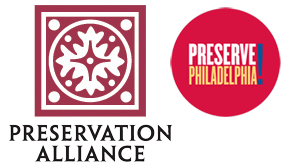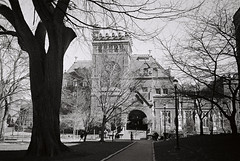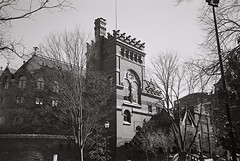Mod Winners Announced
 Montgomery & Bishop’s District Health Center #1, Louis Kahn’s Richards Medical Labs, and I.M. Pei’s Society Hill Towers were among the top vote-getters in the Alliance’s recent “I Like Mod” online poll of Philadelphia’s favorite mid-century modern architecture. Over 1600 votes were cast for 65 buildings in ten categories. Surprise winners included Juniata Park’s Ferko Playground (Parks and Plazas), North Philadelphia’s Holy Cross Lutheran Martin Luther King Jr. Center (Religious Buildings) and a photo-finish tie between Old City’s National Products and Tacony’s Stein Flowers (Storefronts). A few interesting sidenotes: Mitchell/Giurgola buildings took top honors in two categories, while Venturi Scott Brown, despite competing in four categories, failed to rank higher than third place. And of the eleven winning sites, only four (National Products, Society Hill Towers, Richards Medical Labs and the United Fund building) are currently protected on the Philadelphia Register of Historic Places. CLICK HERE or on the ribbon above for the complete list of winners, and thanks to everyone who voted!
Montgomery & Bishop’s District Health Center #1, Louis Kahn’s Richards Medical Labs, and I.M. Pei’s Society Hill Towers were among the top vote-getters in the Alliance’s recent “I Like Mod” online poll of Philadelphia’s favorite mid-century modern architecture. Over 1600 votes were cast for 65 buildings in ten categories. Surprise winners included Juniata Park’s Ferko Playground (Parks and Plazas), North Philadelphia’s Holy Cross Lutheran Martin Luther King Jr. Center (Religious Buildings) and a photo-finish tie between Old City’s National Products and Tacony’s Stein Flowers (Storefronts). A few interesting sidenotes: Mitchell/Giurgola buildings took top honors in two categories, while Venturi Scott Brown, despite competing in four categories, failed to rank higher than third place. And of the eleven winning sites, only four (National Products, Society Hill Towers, Richards Medical Labs and the United Fund building) are currently protected on the Philadelphia Register of Historic Places. CLICK HERE or on the ribbon above for the complete list of winners, and thanks to everyone who voted!
I Like Mod: Polls Close Soon!
You have until this Monday, January 10 to vote for your favorite midcentury Philadelphia buildings and sites in our “I Like Mod” election. CLICK HERE for the ballot. Over a thousand votes have already been tallied, and more importantly, a number of excellent write-in candidates have emerged. But we know there are many more out there. Enjoy the slideshow below featuring some of these write-ins, and send us your own favorite dark horses! The winning buildings will be announced online and in our Winter 2011 newsletter in early February.
Spectrum: Cash, Smash and Carry
In case you can squeeze a little pillaging into your weekend schedule:
http://www.nbcphiladelphia.com/news/sports/Spectrum-Demolition-to-Begin-Monday-106619038.html
If you’d like to pay the Spectrum your last respects in another way, you can vote for it in our “I Like Mod” campaign. It is listed under the “Cultural Heritage Sites,” one of five new categories added to the ballot last week.
Tube Tuesday: WPVI
WPVI, we hardly knew you. Demolished earlier this year, Vincent Kling’s donut-shaped television studio on City Line Avenue sure looks like a keeper in this mod-tastic 1963 glimpse into its design and construction, featuring a star turn by Kling himself. Click on the screenshot above for a link to the video, and apologies in advance for the pre-clip commercial.
Tomorrow’s Landmarks Today
Two things are true about architectural taste:
1) Almost every new style and new generation of buildings will eventually be loathed as out-of-date and ugly.
2) Almost every “out-of-date and ugly” style of building will eventually be appreciated as historic and beautiful.
It was true for Colonial buildings, for Federal buildings, for Victorian buildings, for Beaux-Arts buildings, for Art Deco buildings, and it is true for mid-century modern buildings, too (not to mention post-modern and post-post-modern buildings, but let’s not get ahead of ourselves). The process is gradual and almost alchemical– buildings viewed as interlopers and unwelcome guests one day are eventually forgiven. Styles seen as arbitrary, cheap or false yesterday will assume the gravitas of history tomorrow. It’s like clockwork, but it’s also like watching a pot of water trying to boil. You can never see it until it happens.
Like it or not, it is happening right now for mid-century architecture in Philadelphia. But obviously, not all buildings from this era are equally interesting, significant, or valuable. So the Preservation Alliance created a ballot of Philadelphia buildings, both well-known and overlooked, built between 1945 and 1980. We want you to vote for your favorites. We want you to tell us what we left off (obviously a lot). We even want to know what you’d like to see demolished. You can vote once a day in each category, so vote early and vote often.
The polls are now open for the first five categories, and five more will be released in the coming weeks. Happy voting!
Tube Tuesday: Architectural Wallflowers
In this gem of an interview produced by Temple University, photographer Betsy Manning and professor Ken Finkel (whose Redbricker column for Philly Brownstoner never ceases to amaze/amuse) discuss Manning’s passion for documenting the lesser-known corners of the city. She describes her subjects as “architectural wallflowers”– overlooked, ignored, nondescript, until you stop and really see them. The Preservation Alliance is excited to host Manning as she presents more of her work on Wednesday, October 27 at 6:30 pm at the Northeast Regional Free Library (2228 Cottman Avenue). Free and open to the public, registration is encouraged by emailing ben@preservationalliance.com or calling 215-546-1146 x5.
And a teaser– expect more of Manning’s finds to turn up on Field Notes in the near future….
Tube Tuesday: Greenbelt Knoll
Greenbelt Knoll was designated a Philadelphia Historic District in 2006, and in 2007 the residents of the neighborhood received the Preservation Alliance’s Community Action Award. This short documentary was produced for the Scribe Video Center’s Precious Places series.
For more on Greenbelt Knoll, click here.
The New Batch
A lot of preservation organizations these days are turning their attention toward mid-20th century Modernism. While the questions of “what specifically?” and “how?” continue to spawn debate, the question of “why” is well answered. At least within the preservation community (if not yet in other circles), it is accepted that mid-century Modern buildings are potentially historical and call for proactive measures in terms of both planning and materials conservation.
The National was one of the first postwar buildings to be added to the Philadelphia Register, but that fact shouldn’t give us a false sense of security. Today there are only 7 individually-nominated Modern buildings, and, with the exception of The National, they’re by the big names (Louis Kahn, Richard Neutra, I. M. Pei, et al). There are so many more. Certainly not all warrant the formal protection of the Register (and to push for what Robert Venturi has called “pure” preservation only damages the credibility of the profession). Many are architecturally derivative or culturally insignificant. But all are growing older by the day. We’re going to miss some of them. Or, even if we never do, future Philadelphians will.
Unlisted: Robinson’s
Written and drawn by Ben Leech
Unlisted is a series of portraits highlighting Philadelphia buildings not yet listed on the Philadelphia Register of Historic Places. To learn how to protect a building by nominating it to the Register, click here.
Address: 1020 Market Street
Architect: Victor Gruen and Elsie Krummeck
Built: 1946
 The former Robinson Department Store is maybe the least “Philadelphian” of any building in the city. It looms over Market Street like a Pacific swell breaking over a square city’s streetscape. But the surging tide of modernism the building once promised never really reached us, and today Robinson’s stands frozen and forgotten, like a plastic kiddie pool propped up against an abandoned house. The store was designed by Victor Gruen, who is today mostly demonized for spawning the shopping mall as we know it. But in 1946 Gruen was a new American, having fled Vienna before the war to work in the drafting rooms of the 1939 New York World’s Fair. In the 1940s, he and partner Elsie Krummeck were at the vanguard of commercial architecture, building sleek and radical storefronts in downtowns nationwide. The Market Street store was one of eleven the couple designed for the California-based Grayson-Robinson chain of budget womensware, and each of these Austro-Angelean behemoths was a unique flourish of curves, color, and commerce. They were machines for blinging, and they heralded a bright new era of architecture as advertisement.
The former Robinson Department Store is maybe the least “Philadelphian” of any building in the city. It looms over Market Street like a Pacific swell breaking over a square city’s streetscape. But the surging tide of modernism the building once promised never really reached us, and today Robinson’s stands frozen and forgotten, like a plastic kiddie pool propped up against an abandoned house. The store was designed by Victor Gruen, who is today mostly demonized for spawning the shopping mall as we know it. But in 1946 Gruen was a new American, having fled Vienna before the war to work in the drafting rooms of the 1939 New York World’s Fair. In the 1940s, he and partner Elsie Krummeck were at the vanguard of commercial architecture, building sleek and radical storefronts in downtowns nationwide. The Market Street store was one of eleven the couple designed for the California-based Grayson-Robinson chain of budget womensware, and each of these Austro-Angelean behemoths was a unique flourish of curves, color, and commerce. They were machines for blinging, and they heralded a bright new era of architecture as advertisement.

The Philadelphia store is one of the last to remain standing, but it casts a Dorian Gray-ish pall over Market Street today. The tile mosaic facade is waterstained and pockmarked with bolt-holes from the now-lost Robinson sign. One parapet has been lopped off. Once an elegant arcade with floating glass display cases, the ground floor is now stuffed with standard-issue storefronts, complete with metal security grates and plastic back-lit sign boxes. It’s weird, dirty, and dated– like a Frank Furness building probably looked in 1946.
Gruen’s chickens have come home to roost in the Gallery at Market East across the street– a bustling but architecturally invisible affirmation of Gruen’s later shopping mall ethos. But is it too late to give up on his earlier urban visions?
For further reading:
Hardwick, M. Jeffrey. Mall Maker: Victor Gruen, Architect of an American Dream. Philadelphia: University of Pennsylvania Press, 2004.
Heller, Steven and Heimann, Jim. Shop America: Mid-Century Storefront Design, 1938-1950. Los Angeles: Taschen, 2007.
Jackson, Mike. “Storefronts of Tomorrow: American Storefront Design from 1940 to 1970.” Preserving the Recent Past 2, Deborah Slaton and William G. Foulks, eds. Washington, D.C.: National Park Service, 2000.
Wall, Alex. Victor Gruen: From Urban Shop to New City. Barcelona: Actar, 2005.











